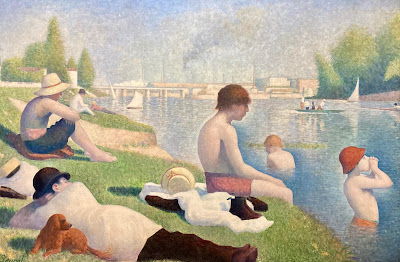Exploring Britain's National Gallery
Although I've made many visits to London and Trafalgar Square (including the days when it was overrun by pigeons!) I've never before had the opportunity to visit Britain's National Gallery (whose imposing facade completes Trafalgar Square).
I am very glad to say I corrected that oversight during this visit.
The current National Gallery, designed by William Wilkins, opened in 1838. The building was initially subjected of scorn due to its location between wealthy and poor neighborhoods (London elites at the time felt it should be in a more regal neighborhood). Also the Trafalger Square site limited the Gallery to a long and narrow footprint.
Over the years it has been subject to numerous piecemeal renovations and additions (including one by American Post Modernists Robert Venturi and Denise Scott Brown). Today the only remnant of the Wilkins design that remains intact is the facade.
The National Gallery
The gallery showcases some 2300 masterpieces from the mid-thirteenth century to 1900. I really appreciated its relatively modest size and perfectly illuminated interiors. Unlike mega museums like the Louvre or the Hermitage, this gallery doesn't require a multi-day commitment to enjoy its offerings. And it houses some breathtaking art including paintings by Leonardo da Vinci, Michelangelo, Picasso and Van Gogh (including his Sunflowers.)
During WWII its treasures had to be relocated to limestone caves in Wales (after Churchill chafed at a plan to temporarily relocate them to Canada.) I loved that while the gallery was empty it was used for noontime musical performances since London's Music Halls had to remain closed.
Here are some of my favorite paintings in the collection.
Bathers at Asnières
(Georges Seurat 1884)
When Impressionist art was becoming important, the National Gallery acquired pieces timidly. Many in charge of acquisitions at the time felt that Impressionism was not serious art and just a passing fad.
Although painted in 1884, the Seurat painting "Bathers at Asnières" was purchased almost 40 years later.
Portrait of a Young Man
(Sandro Botticelli approx. 1480-85)
Probably best known for "Venus on the Halfshell" in the Uffizi in Florence, I found this simple Botticelli painting to be engaging. Despite the paining being 500+ years old it captures the timeless look of youth and innocence.
Another Impressionist favorite of mine was a painting of fisherman by Joaquin Sorolla. When I first came upon one of Sorolla's paintings in Madrid's Prado a decade ago it evoked an immediate emotional response from me.
I welcomed the chance to see another example of his work.
Valencian Fishermen
(Joaquin Sorolla 1895)
Moving on I came upon George Stubbs enormous, and impossible to miss, painting entitled "Whistlejacket". This much adored painting is majestically positioned at the end of one of the National's longest gallery's.
Stubbs painted Whistlejacket without a rider against a blank background to focus all of the energy of the painting on the Arabian stallion.
Leaping and looking over his shoulder at the viewer Whistlejacket is one of those paintings that is simply magnetic. It draws people to it.
Whistlejacket
(George Stubbs about 1762)
Perhaps two of the biggest draws in the National Gallery are Vincent van Gogh's "A Wheatfield, with Cypresses" and "Sunflowers". I was particularly taken by "A Wheatfield, with Cypresses" after visiting the very site in St. Remy where Van Gogh painted it. His art in St. Remy was therapy while he underwent psychological treatment in the asylum that is till there.
A Wheatfield, with Cypresses
(Vincent van Gogh 1889)
I also found the "Arnolfini Portrait" of interest.
The Arnolfini Portrait
(Jan van Eyck 1434)
I have to wonder if Grant Woods might have been influenced by this painting when he created his "American Gothic". There is just something just so stark and formal in the way Jan van Eyck portrayed the wealthy Italian merchant couple in Bruges. I also love the little dog at their feet and how the mirror behind the Arnolfini's lets you see that they are welcoming arriving guests (maybe explaining the raised hand as a gesture of greeting).
Also note the stenciling above the mirror where Jan van Eyck signed his portrait.
The Mirror Detail
As my afternoon in the Gallery neared its end it was clear the gallery had taken its toll on some younger visitors.
Youthful Gallery Fatigue
As our short visit to London was drawing to a close my love for London just grew seeing how each district is so individual and celebrated; whether it is the lanterns of Chinatown or seeing the knight watching a bridge in The City viewed on our walk back to the Elizabeth Line.
The Lanterns of London's Chinatown
Knights and Dragons Guarding a Bridge
Roadboy's Travels © 2023












No comments:
Post a Comment